2005 MERCEDES-BENZ SPRINTER heater
[x] Cancel search: heaterPage 1185 of 1232
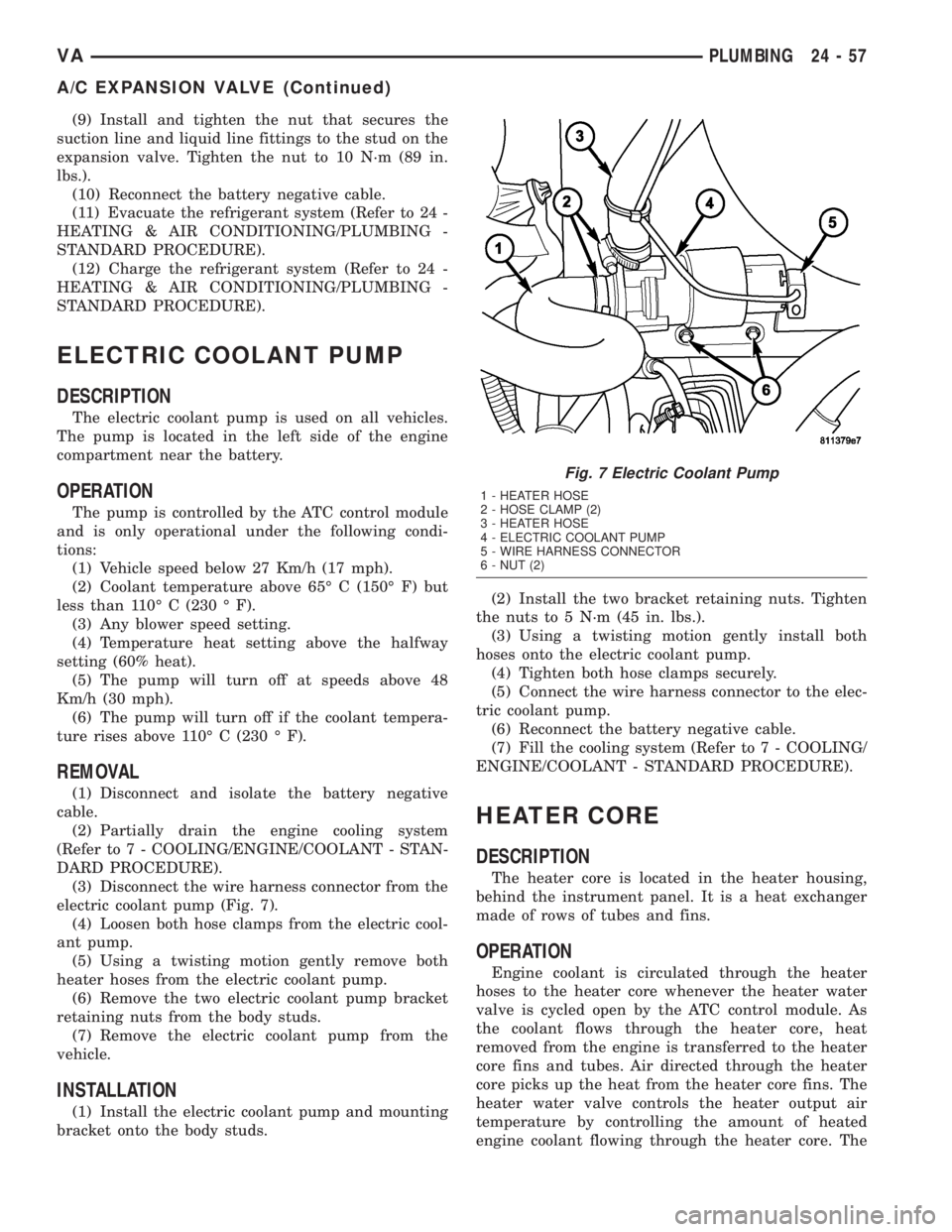
(9) Install and tighten the nut that secures the
suction line and liquid line fittings to the stud on the
expansion valve. Tighten the nut to 10 N´m (89 in.
lbs.).
(10) Reconnect the battery negative cable.
(11) Evacuate the refrigerant system (Refer to 24 -
HEATING & AIR CONDITIONING/PLUMBING -
STANDARD PROCEDURE).
(12) Charge the refrigerant system (Refer to 24 -
HEATING & AIR CONDITIONING/PLUMBING -
STANDARD PROCEDURE).
ELECTRIC COOLANT PUMP
DESCRIPTION
The electric coolant pump is used on all vehicles.
The pump is located in the left side of the engine
compartment near the battery.
OPERATION
The pump is controlled by the ATC control module
and is only operational under the following condi-
tions:
(1) Vehicle speed below 27 Km/h (17 mph).
(2) Coolant temperature above 65É C (150É F) but
less than 110É C (230 É F).
(3) Any blower speed setting.
(4) Temperature heat setting above the halfway
setting (60% heat).
(5) The pump will turn off at speeds above 48
Km/h (30 mph).
(6) The pump will turn off if the coolant tempera-
ture rises above 110É C (230 É F).
REMOVAL
(1) Disconnect and isolate the battery negative
cable.
(2) Partially drain the engine cooling system
(Refer to 7 - COOLING/ENGINE/COOLANT - STAN-
DARD PROCEDURE).
(3) Disconnect the wire harness connector from the
electric coolant pump (Fig. 7).
(4) Loosen both hose clamps from the electric cool-
ant pump.
(5) Using a twisting motion gently remove both
heater hoses from the electric coolant pump.
(6) Remove the two electric coolant pump bracket
retaining nuts from the body studs.
(7) Remove the electric coolant pump from the
vehicle.
INSTALLATION
(1) Install the electric coolant pump and mounting
bracket onto the body studs.(2) Install the two bracket retaining nuts. Tighten
the nuts to 5 N´m (45 in. lbs.).
(3) Using a twisting motion gently install both
hoses onto the electric coolant pump.
(4) Tighten both hose clamps securely.
(5) Connect the wire harness connector to the elec-
tric coolant pump.
(6) Reconnect the battery negative cable.
(7) Fill the cooling system (Refer to 7 - COOLING/
ENGINE/COOLANT - STANDARD PROCEDURE).
HEATER CORE
DESCRIPTION
The heater core is located in the heater housing,
behind the instrument panel. It is a heat exchanger
made of rows of tubes and fins.
OPERATION
Engine coolant is circulated through the heater
hoses to the heater core whenever the heater water
valve is cycled open by the ATC control module. As
the coolant flows through the heater core, heat
removed from the engine is transferred to the heater
core fins and tubes. Air directed through the heater
core picks up the heat from the heater core fins. The
heater water valve controls the heater output air
temperature by controlling the amount of heated
engine coolant flowing through the heater core. The
Fig. 7 Electric Coolant Pump
1 - HEATER HOSE
2 - HOSE CLAMP (2)
3 - HEATER HOSE
4 - ELECTRIC COOLANT PUMP
5 - WIRE HARNESS CONNECTOR
6 - NUT (2)
VAPLUMBING 24 - 57
A/C EXPANSION VALVE (Continued)
Page 1186 of 1232
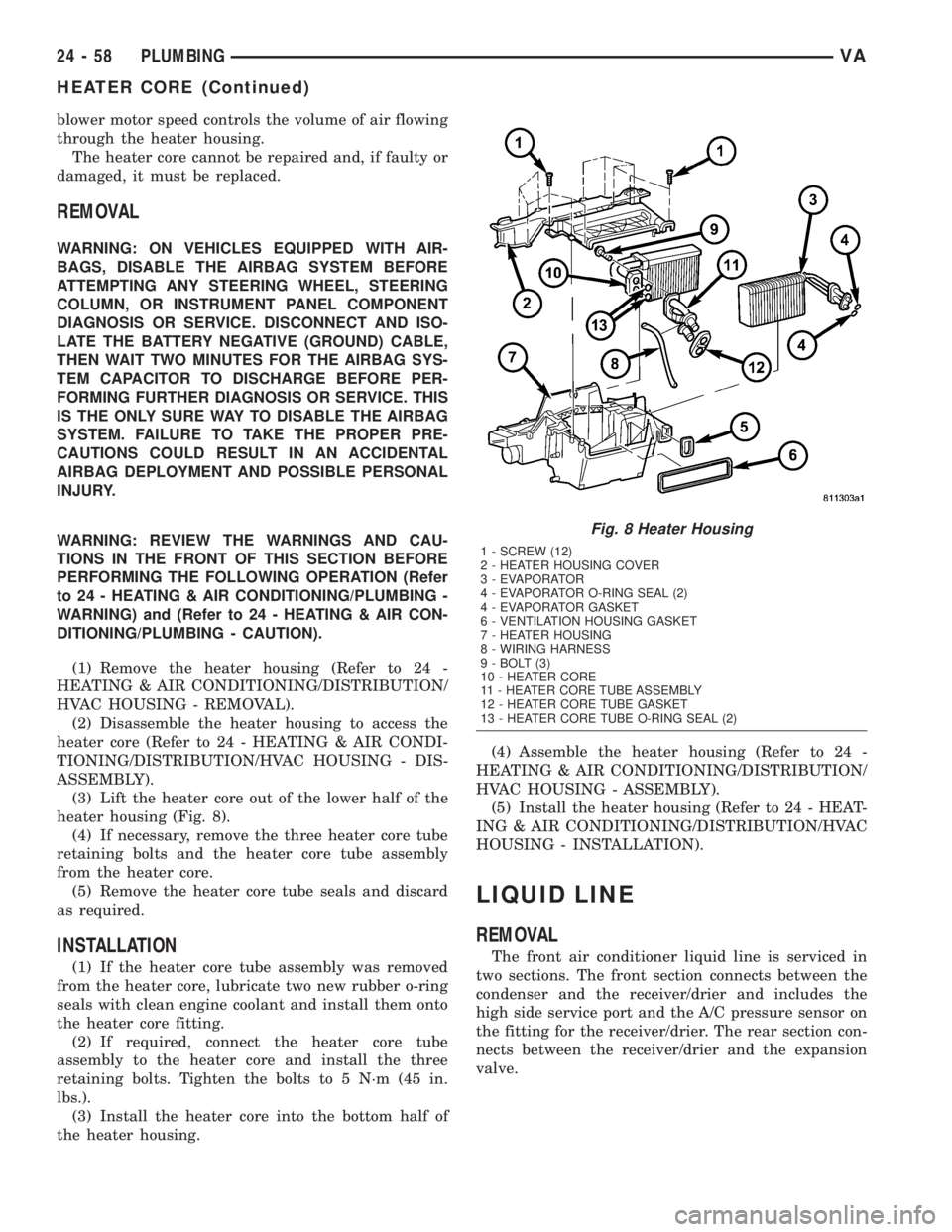
blower motor speed controls the volume of air flowing
through the heater housing.
The heater core cannot be repaired and, if faulty or
damaged, it must be replaced.
REMOVAL
WARNING: ON VEHICLES EQUIPPED WITH AIR-
BAGS, DISABLE THE AIRBAG SYSTEM BEFORE
ATTEMPTING ANY STEERING WHEEL, STEERING
COLUMN, OR INSTRUMENT PANEL COMPONENT
DIAGNOSIS OR SERVICE. DISCONNECT AND ISO-
LATE THE BATTERY NEGATIVE (GROUND) CABLE,
THEN WAIT TWO MINUTES FOR THE AIRBAG SYS-
TEM CAPACITOR TO DISCHARGE BEFORE PER-
FORMING FURTHER DIAGNOSIS OR SERVICE. THIS
IS THE ONLY SURE WAY TO DISABLE THE AIRBAG
SYSTEM. FAILURE TO TAKE THE PROPER PRE-
CAUTIONS COULD RESULT IN AN ACCIDENTAL
AIRBAG DEPLOYMENT AND POSSIBLE PERSONAL
INJURY.
WARNING: REVIEW THE WARNINGS AND CAU-
TIONS IN THE FRONT OF THIS SECTION BEFORE
PERFORMING THE FOLLOWING OPERATION (Refer
to 24 - HEATING & AIR CONDITIONING/PLUMBING -
WARNING) and (Refer to 24 - HEATING & AIR CON-
DITIONING/PLUMBING - CAUTION).
(1) Remove the heater housing (Refer to 24 -
HEATING & AIR CONDITIONING/DISTRIBUTION/
HVAC HOUSING - REMOVAL).
(2) Disassemble the heater housing to access the
heater core (Refer to 24 - HEATING & AIR CONDI-
TIONING/DISTRIBUTION/HVAC HOUSING - DIS-
ASSEMBLY).
(3) Lift the heater core out of the lower half of the
heater housing (Fig. 8).
(4) If necessary, remove the three heater core tube
retaining bolts and the heater core tube assembly
from the heater core.
(5) Remove the heater core tube seals and discard
as required.
INSTALLATION
(1) If the heater core tube assembly was removed
from the heater core, lubricate two new rubber o-ring
seals with clean engine coolant and install them onto
the heater core fitting.
(2) If required, connect the heater core tube
assembly to the heater core and install the three
retaining bolts. Tighten the bolts to 5 N´m (45 in.
lbs.).
(3) Install the heater core into the bottom half of
the heater housing.(4) Assemble the heater housing (Refer to 24 -
HEATING & AIR CONDITIONING/DISTRIBUTION/
HVAC HOUSING - ASSEMBLY).
(5) Install the heater housing (Refer to 24 - HEAT-
ING & AIR CONDITIONING/DISTRIBUTION/HVAC
HOUSING - INSTALLATION).
LIQUID LINE
REMOVAL
The front air conditioner liquid line is serviced in
two sections. The front section connects between the
condenser and the receiver/drier and includes the
high side service port and the A/C pressure sensor on
the fitting for the receiver/drier. The rear section con-
nects between the receiver/drier and the expansion
valve.
Fig. 8 Heater Housing
1 - SCREW (12)
2 - HEATER HOUSING COVER
3 - EVAPORATOR
4 - EVAPORATOR O-RING SEAL (2)
4 - EVAPORATOR GASKET
6 - VENTILATION HOUSING GASKET
7 - HEATER HOUSING
8 - WIRING HARNESS
9 - BOLT (3)
10 - HEATER CORE
11 - HEATER CORE TUBE ASSEMBLY
12 - HEATER CORE TUBE GASKET
13 - HEATER CORE TUBE O-RING SEAL (2)
24 - 58 PLUMBINGVA
HEATER CORE (Continued)
Page 1189 of 1232
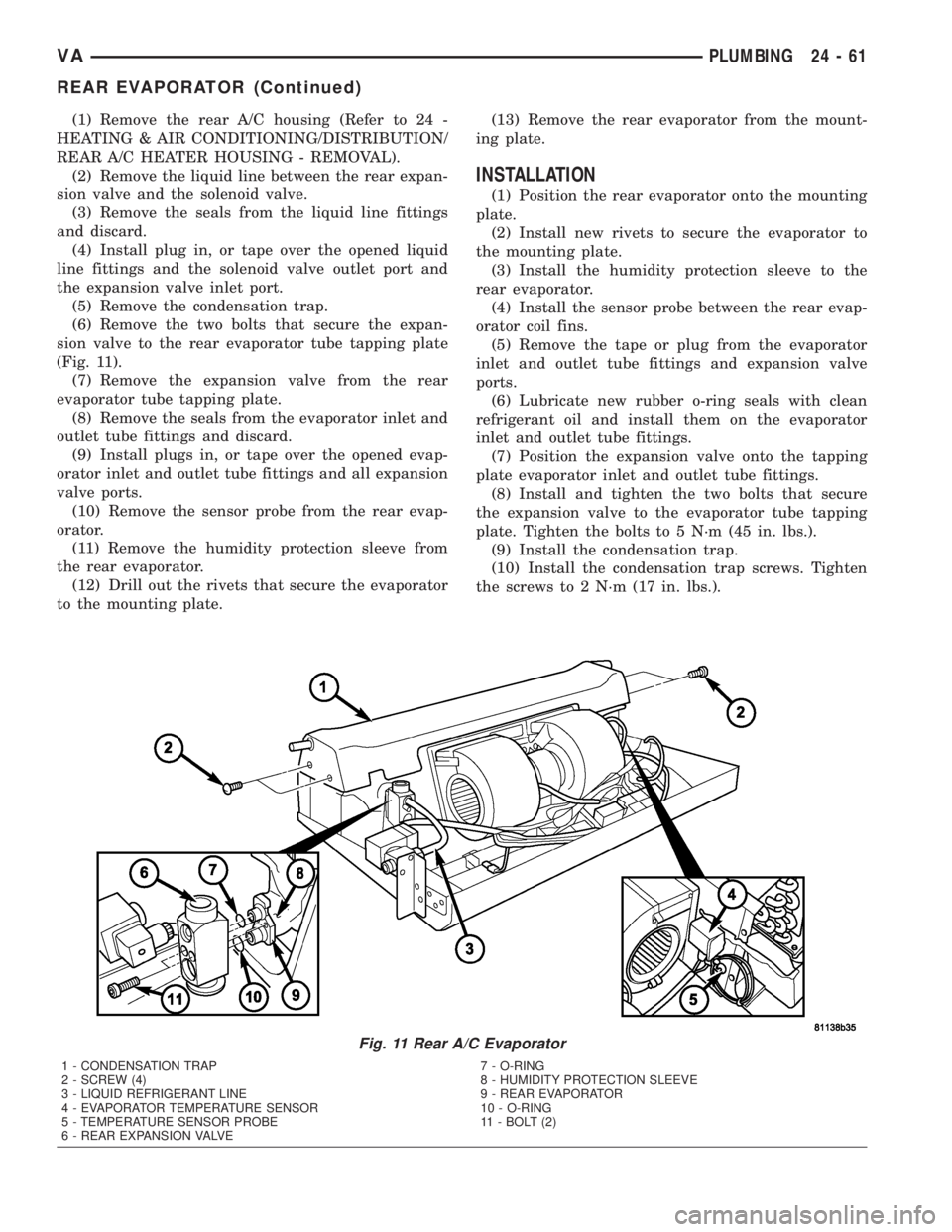
(1) Remove the rear A/C housing (Refer to 24 -
HEATING & AIR CONDITIONING/DISTRIBUTION/
REAR A/C HEATER HOUSING - REMOVAL).
(2) Remove the liquid line between the rear expan-
sion valve and the solenoid valve.
(3) Remove the seals from the liquid line fittings
and discard.
(4) Install plug in, or tape over the opened liquid
line fittings and the solenoid valve outlet port and
the expansion valve inlet port.
(5) Remove the condensation trap.
(6) Remove the two bolts that secure the expan-
sion valve to the rear evaporator tube tapping plate
(Fig. 11).
(7) Remove the expansion valve from the rear
evaporator tube tapping plate.
(8) Remove the seals from the evaporator inlet and
outlet tube fittings and discard.
(9) Install plugs in, or tape over the opened evap-
orator inlet and outlet tube fittings and all expansion
valve ports.
(10) Remove the sensor probe from the rear evap-
orator.
(11) Remove the humidity protection sleeve from
the rear evaporator.
(12) Drill out the rivets that secure the evaporator
to the mounting plate.(13) Remove the rear evaporator from the mount-
ing plate.
INSTALLATION
(1) Position the rear evaporator onto the mounting
plate.
(2) Install new rivets to secure the evaporator to
the mounting plate.
(3) Install the humidity protection sleeve to the
rear evaporator.
(4) Install the sensor probe between the rear evap-
orator coil fins.
(5) Remove the tape or plug from the evaporator
inlet and outlet tube fittings and expansion valve
ports.
(6) Lubricate new rubber o-ring seals with clean
refrigerant oil and install them on the evaporator
inlet and outlet tube fittings.
(7) Position the expansion valve onto the tapping
plate evaporator inlet and outlet tube fittings.
(8) Install and tighten the two bolts that secure
the expansion valve to the evaporator tube tapping
plate. Tighten the bolts to 5 N´m (45 in. lbs.).
(9) Install the condensation trap.
(10) Install the condensation trap screws. Tighten
the screws to 2 N´m (17 in. lbs.).
Fig. 11 Rear A/C Evaporator
1 - CONDENSATION TRAP
2 - SCREW (4)
3 - LIQUID REFRIGERANT LINE
4 - EVAPORATOR TEMPERATURE SENSOR
5 - TEMPERATURE SENSOR PROBE
6 - REAR EXPANSION VALVE7 - O-RING
8 - HUMIDITY PROTECTION SLEEVE
9 - REAR EVAPORATOR
10 - O-RING
11 - BOLT (2)
VAPLUMBING 24 - 61
REAR EVAPORATOR (Continued)
Page 1190 of 1232
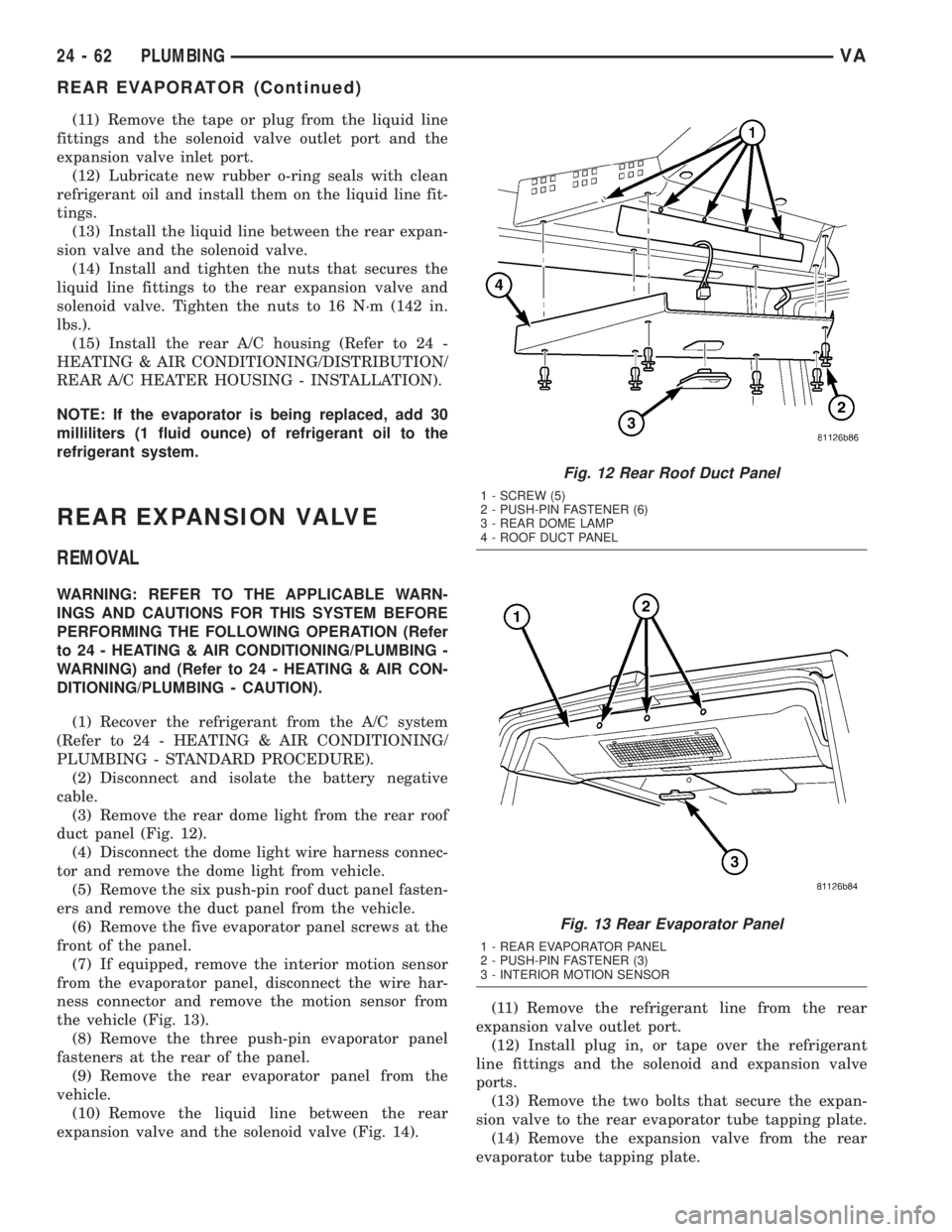
(11) Remove the tape or plug from the liquid line
fittings and the solenoid valve outlet port and the
expansion valve inlet port.
(12) Lubricate new rubber o-ring seals with clean
refrigerant oil and install them on the liquid line fit-
tings.
(13) Install the liquid line between the rear expan-
sion valve and the solenoid valve.
(14) Install and tighten the nuts that secures the
liquid line fittings to the rear expansion valve and
solenoid valve. Tighten the nuts to 16 N´m (142 in.
lbs.).
(15) Install the rear A/C housing (Refer to 24 -
HEATING & AIR CONDITIONING/DISTRIBUTION/
REAR A/C HEATER HOUSING - INSTALLATION).
NOTE: If the evaporator is being replaced, add 30
milliliters (1 fluid ounce) of refrigerant oil to the
refrigerant system.
REAR EXPANSION VALVE
REMOVAL
WARNING: REFER TO THE APPLICABLE WARN-
INGS AND CAUTIONS FOR THIS SYSTEM BEFORE
PERFORMING THE FOLLOWING OPERATION (Refer
to 24 - HEATING & AIR CONDITIONING/PLUMBING -
WARNING) and (Refer to 24 - HEATING & AIR CON-
DITIONING/PLUMBING - CAUTION).
(1) Recover the refrigerant from the A/C system
(Refer to 24 - HEATING & AIR CONDITIONING/
PLUMBING - STANDARD PROCEDURE).
(2) Disconnect and isolate the battery negative
cable.
(3) Remove the rear dome light from the rear roof
duct panel (Fig. 12).
(4) Disconnect the dome light wire harness connec-
tor and remove the dome light from vehicle.
(5) Remove the six push-pin roof duct panel fasten-
ers and remove the duct panel from the vehicle.
(6) Remove the five evaporator panel screws at the
front of the panel.
(7) If equipped, remove the interior motion sensor
from the evaporator panel, disconnect the wire har-
ness connector and remove the motion sensor from
the vehicle (Fig. 13).
(8) Remove the three push-pin evaporator panel
fasteners at the rear of the panel.
(9) Remove the rear evaporator panel from the
vehicle.
(10) Remove the liquid line between the rear
expansion valve and the solenoid valve (Fig. 14).(11) Remove the refrigerant line from the rear
expansion valve outlet port.
(12) Install plug in, or tape over the refrigerant
line fittings and the solenoid and expansion valve
ports.
(13) Remove the two bolts that secure the expan-
sion valve to the rear evaporator tube tapping plate.
(14) Remove the expansion valve from the rear
evaporator tube tapping plate.
Fig. 12 Rear Roof Duct Panel
1 - SCREW (5)
2 - PUSH-PIN FASTENER (6)
3 - REAR DOME LAMP
4 - ROOF DUCT PANEL
Fig. 13 Rear Evaporator Panel
1 - REAR EVAPORATOR PANEL
2 - PUSH-PIN FASTENER (3)
3 - INTERIOR MOTION SENSOR
24 - 62 PLUMBINGVA
REAR EVAPORATOR (Continued)
Page 1195 of 1232
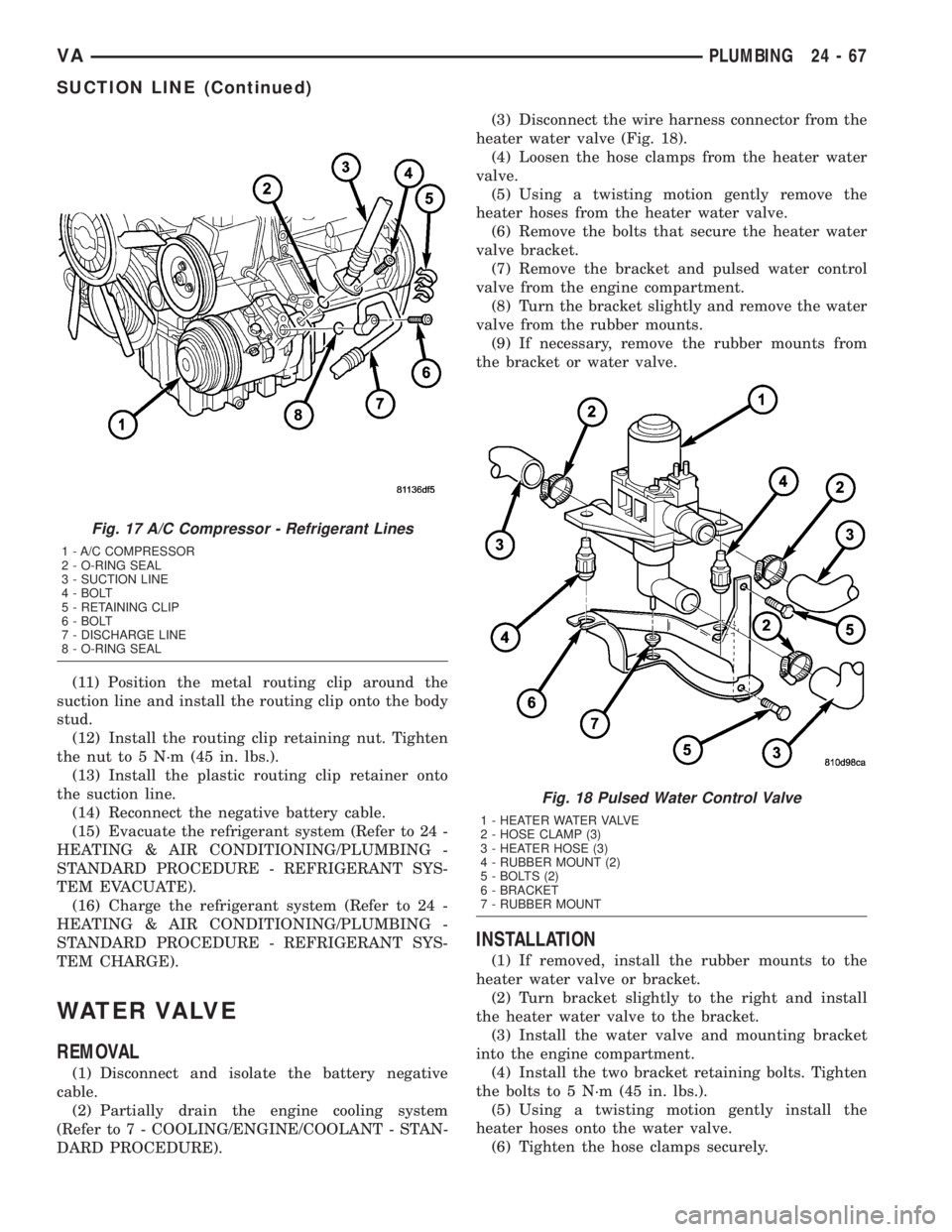
(11) Position the metal routing clip around the
suction line and install the routing clip onto the body
stud.
(12) Install the routing clip retaining nut. Tighten
the nut to 5 N´m (45 in. lbs.).
(13) Install the plastic routing clip retainer onto
the suction line.
(14) Reconnect the negative battery cable.
(15) Evacuate the refrigerant system (Refer to 24 -
HEATING & AIR CONDITIONING/PLUMBING -
STANDARD PROCEDURE - REFRIGERANT SYS-
TEM EVACUATE).
(16) Charge the refrigerant system (Refer to 24 -
HEATING & AIR CONDITIONING/PLUMBING -
STANDARD PROCEDURE - REFRIGERANT SYS-
TEM CHARGE).
WATER VALVE
REMOVAL
(1) Disconnect and isolate the battery negative
cable.
(2) Partially drain the engine cooling system
(Refer to 7 - COOLING/ENGINE/COOLANT - STAN-
DARD PROCEDURE).(3) Disconnect the wire harness connector from the
heater water valve (Fig. 18).
(4) Loosen the hose clamps from the heater water
valve.
(5) Using a twisting motion gently remove the
heater hoses from the heater water valve.
(6) Remove the bolts that secure the heater water
valve bracket.
(7) Remove the bracket and pulsed water control
valve from the engine compartment.
(8) Turn the bracket slightly and remove the water
valve from the rubber mounts.
(9) If necessary, remove the rubber mounts from
the bracket or water valve.
INSTALLATION
(1) If removed, install the rubber mounts to the
heater water valve or bracket.
(2) Turn bracket slightly to the right and install
the heater water valve to the bracket.
(3) Install the water valve and mounting bracket
into the engine compartment.
(4) Install the two bracket retaining bolts. Tighten
the bolts to 5 N´m (45 in. lbs.).
(5) Using a twisting motion gently install the
heater hoses onto the water valve.
(6) Tighten the hose clamps securely.
Fig. 17 A/C Compressor - Refrigerant Lines
1 - A/C COMPRESSOR
2 - O-RING SEAL
3 - SUCTION LINE
4 - BOLT
5 - RETAINING CLIP
6 - BOLT
7 - DISCHARGE LINE
8 - O-RING SEAL
Fig. 18 Pulsed Water Control Valve
1 - HEATER WATER VALVE
2 - HOSE CLAMP (3)
3 - HEATER HOSE (3)
4 - RUBBER MOUNT (2)
5 - BOLTS (2)
6 - BRACKET
7 - RUBBER MOUNT
VAPLUMBING 24 - 67
SUCTION LINE (Continued)
Page 1196 of 1232

(7) Connect the wire harness connector to the
heater water valve.
(8) Reconnect the battery negative cable.
(9) Fill the cooling system (Refer to 7 - COOLING/
ENGINE/COOLANT - STANDARD PROCEDURE).
UNDERBODY LINES
REMOVAL
The rear refrigerant lines for the optional rear A/C
system is serviced in four sections. The liquid line for
the optional rear A/C system uses a spring-lock
refrigerant line coupler which requires the use of a
3/8 inch quick-disconnect tool (part of Special Tool,
A/C Line Disconnect Kit 7193).
WARNING: REVIEW THE WARNINGS AND CAU-
TIONS IN THE FRONT OF THIS SECTION BEFORE
PERFORMING THE FOLLOWING OPERATION (Refer
to 24 - HEATING & AIR CONDITIONING/PLUMBING -
WARNING) and (Refer to 24 - HEATING & AIR CON-
DITIONING/PLUMBING - CAUTION).
FRONT LIQUID LINE
(1) Recover the refrigerant from the refrigerant
system (Refer to 24 - HEATING & AIR CONDITION-
ING/PLUMBING - STANDARD PROCEDURE).
(2) Disconnect and isolate the battery negative
cable.
(3) Disconnect the rear section of the front liquid
line from the receiver-drier and the evaporator (Refer
to 24 - HEATING & AIR CONDITIONING/PLUMB-
ING/LIQUID LINE - REMOVAL).
(4) Disconnect the fitting to the intermediate liq-
uid line using Special Tool, A/C Line Disconnect Kit
7193.
(5) Remove the seals from the liquid line fittings
and discard.
(6) Install plug in, or tape over the open liquid line
fittings, the reciever-drier outlet port and the expan-
sion valve ports.
(7) Remove the front liquid line from the engine
compartment.
FRONT SUCTION LINE
(1) Recover the refrigerant from the refrigerant
system (Refer to 24 - HEATING & AIR CONDITION-
ING/PLUMBING - STANDARD PROCEDURE).
(2) Disconnect and isolate the battery negative
cable.
(3) Remove the nut that secures the intermediate
suction line fitting to the stud on the front suction
line tapping plate.
(4) Disconnect the intermediate suction line fitting
from the front suction line tapping plate.(5) Install plug in, or tape over the open suction
line fitting and the front suction line tapping plate
inlet port.
(6) Disconnect the front suction line from the com-
pressor and front evaporator valve (Refer to 24 -
HEATING & AIR CONDITIONING/PLUMBING/
SUCTION LINE - REMOVAL).
(7) Remove the seals from the open suction line fit-
tings and discard.
(8) Install plug in, or tape over the open suction
line fittings, the compressor inlet port and the expan-
sion valve ports.
(9) Remove the front suction line from the engine
compartment.
(10) If necessary, remove the bolt that secures the
compressor portion of the front suction line to the
front suction line tapping plate, separate the front
suction lines, remove and discard the seal and, plug
in, or tape over the open suction line fittings.
INTERMEDIATE REFRIGERANT LINES
(1) Recover the refrigerant from the refrigerant
system (Refer to 24 - HEATING & AIR CONDITION-
ING/PLUMBING/REFRIGERANT - STANDARD
PROCEDURE).
(2) Disconnect and isolate the battery negative
cable.
(3) Disconnect the intermediate liquid line from
the front liquid line using Special Tool, A/C Line Dis-
connect Kit 7193.
(4) Remove the nut that secures the intermediate
suction line fitting to the stud on the front suction
line tapping plate.
(5) Disconnect the intermediate suction line from
the front suction line tapping plate.
(6) Remove the seals from the liquid and suction
line fittings and discard.
(7) Install plug in, or tape over the open suction
and liquid line fittings and the front suction line tap-
ping plate inlet port.
(8) Raise and support the vehicle.
(9) Disconnect the fittings that secure the interme-
diate refrigerant lines to the rear refrigerant lines.
(10) Remove the seals from the open liquid and
suction line fittings and discard.
(11) Install plugs in, or tape over the open liquid
and suction line fittings.
(12) Remove the bolts that secure the two interme-
diate refrigerant line retaining blocks to the vehicle
underbody.
(13) Remove the intermediate section of the rear
refrigerant lines from the vehicle underbody.
REAR REFRIGERANT LINES
(1) Recover the refrigerant from the refrigerant
system (Refer to 24 - HEATING & AIR CONDITION-
24 - 68 PLUMBINGVA
WATER VALVE (Continued)
Page 1200 of 1232
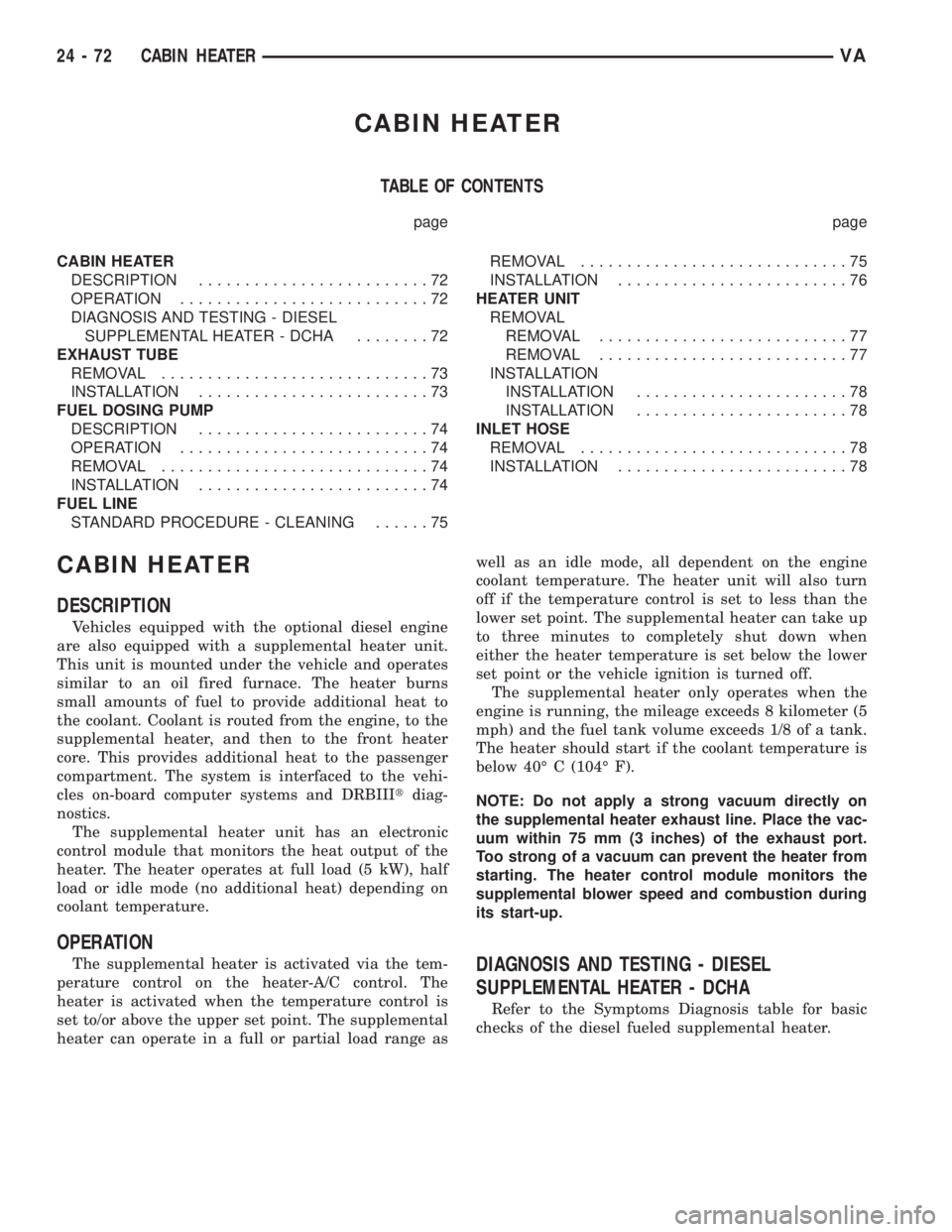
CABIN HEATER
TABLE OF CONTENTS
page page
CABIN HEATER
DESCRIPTION.........................72
OPERATION...........................72
DIAGNOSIS AND TESTING - DIESEL
SUPPLEMENTAL HEATER - DCHA........72
EXHAUST TUBE
REMOVAL.............................73
INSTALLATION.........................73
FUEL DOSING PUMP
DESCRIPTION.........................74
OPERATION...........................74
REMOVAL.............................74
INSTALLATION.........................74
FUEL LINE
STANDARD PROCEDURE - CLEANING......75REMOVAL.............................75
INSTALLATION.........................76
HEATER UNIT
REMOVAL
REMOVAL...........................77
REMOVAL...........................77
INSTALLATION
INSTALLATION.......................78
INSTALLATION.......................78
INLET HOSE
REMOVAL.............................78
INSTALLATION.........................78
CABIN HEATER
DESCRIPTION
Vehicles equipped with the optional diesel engine
are also equipped with a supplemental heater unit.
This unit is mounted under the vehicle and operates
similar to an oil fired furnace. The heater burns
small amounts of fuel to provide additional heat to
the coolant. Coolant is routed from the engine, to the
supplemental heater, and then to the front heater
core. This provides additional heat to the passenger
compartment. The system is interfaced to the vehi-
cles on-board computer systems and DRBIIItdiag-
nostics.
The supplemental heater unit has an electronic
control module that monitors the heat output of the
heater. The heater operates at full load (5 kW), half
load or idle mode (no additional heat) depending on
coolant temperature.
OPERATION
The supplemental heater is activated via the tem-
perature control on the heater-A/C control. The
heater is activated when the temperature control is
set to/or above the upper set point. The supplemental
heater can operate in a full or partial load range aswell as an idle mode, all dependent on the engine
coolant temperature. The heater unit will also turn
off if the temperature control is set to less than the
lower set point. The supplemental heater can take up
to three minutes to completely shut down when
either the heater temperature is set below the lower
set point or the vehicle ignition is turned off.
The supplemental heater only operates when the
engine is running, the mileage exceeds 8 kilometer (5
mph) and the fuel tank volume exceeds 1/8 of a tank.
The heater should start if the coolant temperature is
below 40É C (104É F).
NOTE: Do not apply a strong vacuum directly on
the supplemental heater exhaust line. Place the vac-
uum within 75 mm (3 inches) of the exhaust port.
Too strong of a vacuum can prevent the heater from
starting. The heater control module monitors the
supplemental blower speed and combustion during
its start-up.DIAGNOSIS AND TESTING - DIESEL
SUPPLEMENTAL HEATER - DCHA
Refer to the Symptoms Diagnosis table for basic
checks of the diesel fueled supplemental heater.
24 - 72 CABIN HEATERVA
Page 1201 of 1232
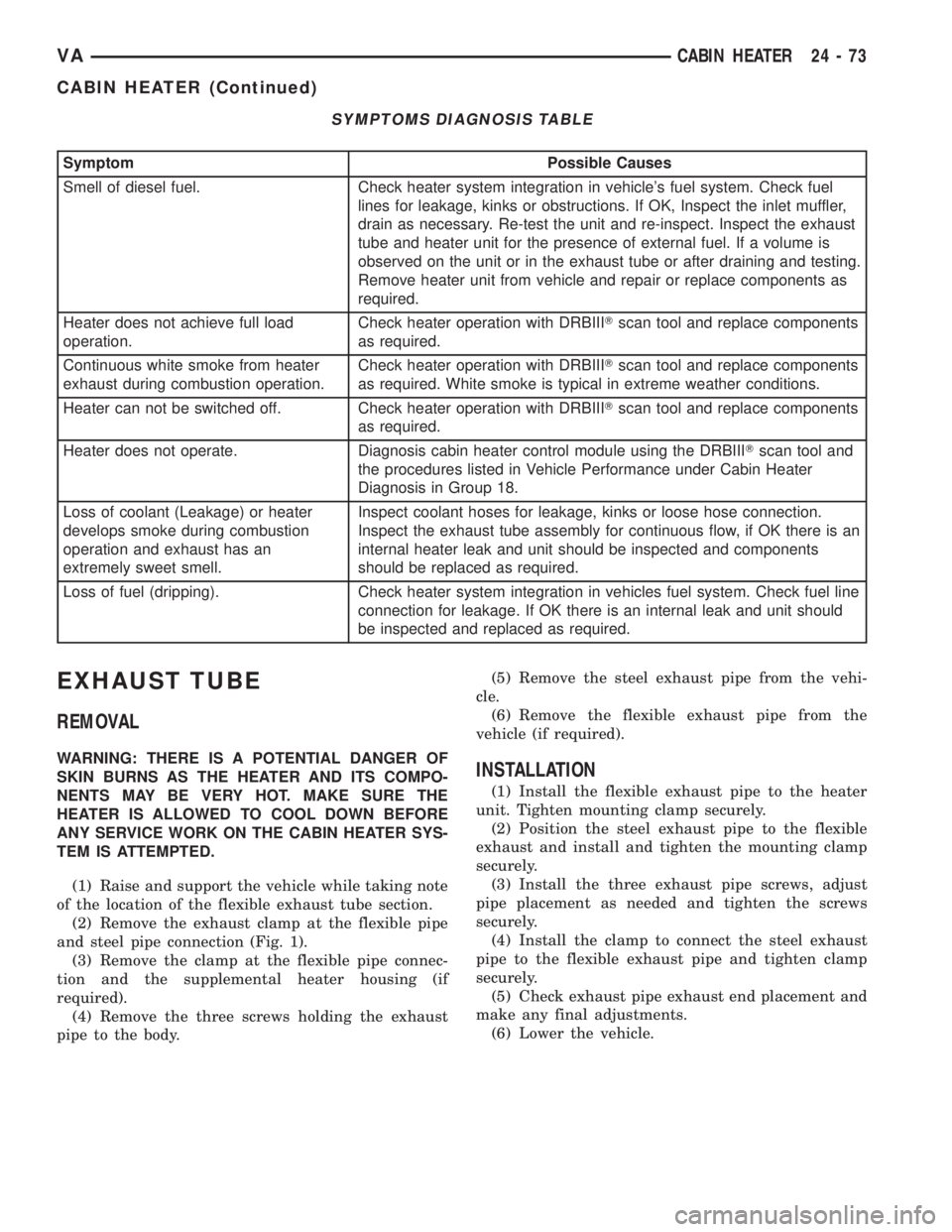
SYMPTOMS DIAGNOSIS TABLE
Symptom Possible Causes
Smell of diesel fuel. Check heater system integration in vehicle's fuel system. Check fuel
lines for leakage, kinks or obstructions. If OK, Inspect the inlet muffler,
drain as necessary. Re-test the unit and re-inspect. Inspect the exhaust
tube and heater unit for the presence of external fuel. If a volume is
observed on the unit or in the exhaust tube or after draining and testing.
Remove heater unit from vehicle and repair or replace components as
required.
Heater does not achieve full load
operation.Check heater operation with DRBIIITscan tool and replace components
as required.
Continuous white smoke from heater
exhaust during combustion operation.Check heater operation with DRBIIITscan tool and replace components
as required. White smoke is typical in extreme weather conditions.
Heater can not be switched off. Check heater operation with DRBIIITscan tool and replace components
as required.
Heater does not operate. Diagnosis cabin heater control module using the DRBIIITscan tool and
the procedures listed in Vehicle Performance under Cabin Heater
Diagnosis in Group 18.
Loss of coolant (Leakage) or heater
develops smoke during combustion
operation and exhaust has an
extremely sweet smell.Inspect coolant hoses for leakage, kinks or loose hose connection.
Inspect the exhaust tube assembly for continuous flow, if OK there is an
internal heater leak and unit should be inspected and components
should be replaced as required.
Loss of fuel (dripping). Check heater system integration in vehicles fuel system. Check fuel line
connection for leakage. If OK there is an internal leak and unit should
be inspected and replaced as required.
EXHAUST TUBE
REMOVAL
WARNING: THERE IS A POTENTIAL DANGER OF
SKIN BURNS AS THE HEATER AND ITS COMPO-
NENTS MAY BE VERY HOT. MAKE SURE THE
HEATER IS ALLOWED TO COOL DOWN BEFORE
ANY SERVICE WORK ON THE CABIN HEATER SYS-
TEM IS ATTEMPTED.
(1) Raise and support the vehicle while taking note
of the location of the flexible exhaust tube section.
(2) Remove the exhaust clamp at the flexible pipe
and steel pipe connection (Fig. 1).
(3) Remove the clamp at the flexible pipe connec-
tion and the supplemental heater housing (if
required).
(4) Remove the three screws holding the exhaust
pipe to the body.(5) Remove the steel exhaust pipe from the vehi-
cle.
(6) Remove the flexible exhaust pipe from the
vehicle (if required).INSTALLATION
(1) Install the flexible exhaust pipe to the heater
unit. Tighten mounting clamp securely.
(2) Position the steel exhaust pipe to the flexible
exhaust and install and tighten the mounting clamp
securely.
(3) Install the three exhaust pipe screws, adjust
pipe placement as needed and tighten the screws
securely.
(4) Install the clamp to connect the steel exhaust
pipe to the flexible exhaust pipe and tighten clamp
securely.
(5) Check exhaust pipe exhaust end placement and
make any final adjustments.
(6) Lower the vehicle.
VACABIN HEATER 24 - 73
CABIN HEATER (Continued)